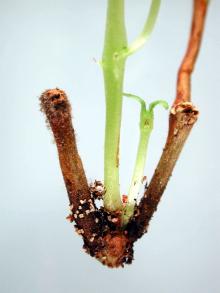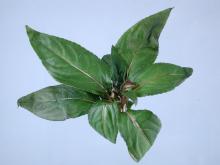See:
Greenhouse Plants, Ornamental - Gray Mold
Cause Botrytis cinerea, a fungus. Survives in plant debris, favored by high moisture and low temperatures. Under cool, humid conditions, and low light levels in greenhouses, the disease spreads rapidly. Severe water stress in the spring can cause fuchsia flower buds to abort and lower leaf yellowing or defoliation. This in turn can encourage more disease development as this fungus colonized these dead or weakened tissues. Growing fuchsias under conditions that are too warm can result in soft plants that cannot withstand shipping.
Symptoms Infected leaves and flower parts develop a soft, brown decay. Stems can develop dark cankered areas resulting in wilting of foliage above that point. In humid conditions, a fuzzy fungal growth that is brown-to-gray appears around the infected tissues.
Cultural control
- Remove and destroy infected tissues or fallen plant debris such as spent or aborted flowers.
- Increase ventilation and air circulation, and keep plants dry.
- Increase plant spacing for improved air circulation.
- Do not moisten the leaves when watering.
- Allow to dry between irrigations especially during short days.
- Maintain growing temperatures in low 60s for day and high 50s for night, which can be increased to the mid 60s (negative DIF) once plants are in hanging baskets. If using DROP or DIP for size control, do not let humidity rise above 90%.
Chemical control Best when used with cultural controls. Tank-mix and/or alternate products from different groups with different modes of action to prevent the buildup of resistant fungi. Limit the use of any one group during the growing season.
- Astun at 10 to 17 fl oz/100 gal water. Group 7 fungicide. 12-hr reentry.
- Decree 50 WDG at 0.75 to 1.5 lb/100 gal water. Group 17 fungicide. 12-hr reentry.
- Mancozeb-based products can be used as mixing partners and provide some protection. Group M3 fungicides. 24-hr reentry.
- Fore 80 WP at 1.5 lb/100 gal water plus a spreader-sticker.
- Protect DF at 1 to 2 lb/100 gal water plus 2 to 4 oz spreader-sticker.
- Medallion WDG at 2 to 4 oz/100 gal water. Use with oils or adjuvants may damage plant. Group 12 fungicide. 12-hr reentry.
- OHP 6672 4.5 F at 10 to 14.5 fl oz/100 gal water plus another fungicide. Group 1 fungicide. 12-hr reentry.
- Palladium at 4 to 6 oz/100 gal water. Avoid excessive runoff to small plants, which may result in stunting and/or chlorosis. Group 9 + 12 fungicide. 12-hr reentry.
- Phyton 27 at 1.3 to 2 fl oz/10 gal water. Group M1 fungicide. 48-hr reentry.
- Spirato GHN at 2 to 4 fl oz/100 gal water. Use with oils or adjuvants may cause plant damage. Group 12 fungicide. 12-hr reentry.
- Terraguard SC at 4 to 8 fl oz/100 gal water. Group 3 fungicide. 12-hr reentry.
Biological control
- LALStop G46 WG (Clonostachys rosea [formerly Gliocladium catenulatum] strain J1446) at 0.13 oz/1 gal water. Do not use with other products in the tank. 4-hr reentry. O
Reference Friedrich, S., Gebelein, D., and Boyle, C. 2005. Control of Botrytis cinerea in glasshouse fuchsia by specific climate management. European Journal of Plant Pathology 111: 249-262.


